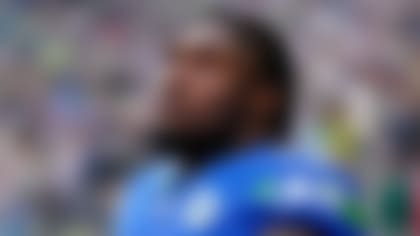*Mike Oliver has been the executive director and general counsel for the National Operating Committee on Standards for Athletic Equipment since 1995. He manages the day-to-day operations and deals with issues regarding performance, safety and injury prevention of athletic equipment that has been certified to the NOCSAE standards. *
Oliver has regularly provided support to various sport governing bodies, including the NCAA and the National Federation of State High School Associations. His organization's logo can be seen on every certified football helmet.
Last week he presided over NOCSAE's semi-annual meeting in Phoenix to review new research in the field of sports-related concussions and to award new research grants. In between sessions Friday, he talked with NFL Evolution contributing editor Bill Bradley about how the organization works with helmet manufacturers, its role in the recent Guardian Cap controversy and the future of NOCSAE.
What is the mission of NOCSAE?
We have a three-part mission. ... First of all, it is to encourage and support research and science in the area of sports injuries. The second is to disseminate information that is developed through sports research or other sources. And the third is to develop standards where feasible for athletic equipment.
With concussion research reaching new heights in the past five years, how has that affected NOCSAE?
We were first in receiving funding that would let us support research of any significance back in 1993. The first research that we funded was at a place in Salt Lake City called OBI that was looking at concussions in freestyle skiing. ... We spent almost $6 million in concussion-specific research-grant funding before 2008. It's been a topic for us for 15 years. For a long time, we were the only group out there that was raising that flag, saying, "This is an issue and we're trying to work on it and we're trying to develop the ways to understand not only how concussions occur but finding if there's something we can do with the helmet standards that might help alleviate that." The issue has grown since 2010, but the benefit to us is that there are more people in the game funding research and I think science is moving along much more quickly.
Head injury experts say there is no helmet that can prevent a concussion. What is NOCSAE'S view on that?
I think it will always be a fact that there will never be a helmet that prevents all concussions. I just don't think you can do that, especially since there are concussions that don't involve a blow to the head. ... I think there is a probable chance that in the future there will be a standard for a helmet to reduce the likelihood of concussions or the severity of concussions. However, I don't think it's fair to say no helmet does anything. I can say right now that a football helmet prevents a number of concussions. I just don't have a way to measure it. It's measuring a non-event. This is what's phenomenal: In the course of a football season at the high school, college and pro level, there are almost 1 billion hits to the helmet during practices and games where it is a measureable blow that would trigger a system to capture these blows. Out of those you have a lot of concussions -- the number is big -- but as a percentage it is very, very small. Think about 99.96 percent of those hits don't result in a diagnosed concussion. It's not to say that things are good and that it's acceptable. But without a helmet or with a poorly designed helmet, I'm sure the number of concussions would be dramatically higher. I know our standard does have a protecting effect against concussions. I can't call it a concussion standard because that's not what it's intended to do. I think a helmet can be better. At some point it can be designed to specifically address concussions. I just can't tell you when that's going to be. We would hope it could be next year, but I just don't know.
What's next for NOCSAE, especially with heightened awareness over concussions?
What we've been working on incredibly diligently for the last two years is to direct research so we can come up with a component to our helmet standard that would make a measureable improvement in the ability of football helmets and all sports helmets to manage concussions. That would mean preventing them or reducing the severity or the frequency of them. ... It's a little hard to show because the way all standards work is you have to have an identifiable threshold of injury. For instance, we might be told you have 100G hits to the head and you'll get 60 concussions out of 100 hits. But if you can get it below 100G, you can reduce concussions by 90 percent. That's a threshold and we'll put that in as a standard. The problem is there isn't any science that says what the threshold really is. ... And there are a lot of variables. There are concussions that have nothing to do with helmets and there are concussions that occur without getting hit in the head. You're not going to get rid of all of them. ... Hopefully by the end of the day, we'll see this information, we'll take the data and see if there's a concrete direction we can go. At some point we want to come up with a graphed standard that would include a component for requiring helmets to meet a certain level to be protective of concussions.
Does this mean your semi-annual meeting could be ground-breaking for NOCSAE in terms of moving to the next level?
It may not be ground-breaking because we've been going up this hill for several years. It's sort of like were getting to the top of the hill or at least we're close enough that we can see what's on the top. One of things that we're going to see (at the conference) ... is that we're really close to the amount of research we need in order to say, "Yes, here's your threshold." ... There will be some differing opinions whether we're at that time or we need to do a little more work, but the point is we are decades closer than we were five years ago.
How does NOCSAE work with the now-famous helmet ratings that are conducted by a group led by Dr. Stefan Duma at Virginia Tech University?
We work with them. In fact, a big part of their system utilizes our standard and testing protocol. We had (Dr. Duma) and ... a number of others down in the laboratory that we have in Knoxville (Tenn.) and got them up to speed on that program.... We have a long-standing relationship with them. We've always encouraged the work they're doing. We have reservations about whether in fact you can draw the conclusions from their STAR rating program that they seem to draw on. But we support anybody doing research to better understand how to protect against a concussion or how to minimize that.
How are NOCSAE's standards different from the STAR ratings?
One of the distinctions that I think some people don't know is that the program that Dr. Duma put together (at Virginia Tech) is not a standards program. In other words, it doesn't say the helmet must do this or must do that. They were looking for a way to compare Helmet A to Helmet B. Under their theory, "I ought to be able to look at Helmet A and test it, look at Helmet B and test it, compare those two and tell you which one is more likely to be protective of concussions than the other." That is not a standard. It's sort of like the national highway safety group that does crash test standards and the 5-star ratings for cars. They don't specify what the car should do; they just compare Car 1 with Car 2. Standard is something that says, "If you're going to make a helmet and you want to certify it a standard, you have to do these four or five points required by the standard." It's the same across the board. It involves things like quality control, quality assurance. It requires outside laboratory validation testing. We don't tell manufacturers how to make a helmet. We just tell them what it has to do. We're not mutually exclusive (from Virginia Tech's ratings). Both work side by side. We're just different.
What are the standards that NOCSAE lives by?
Our standards are based on a long line of well-established science with regard to forces that cause potentially catastrophic injuries to the head. When we were initially formed, it was to address skull fractures, subdural bleeding -- those type of injuries that were actually killing up to 30-35 football players a year back in the late 1960s. The standard address to those (injuries) was by limiting those that occur when a helmet hits, the same forces that are involved in causing a concussion. There is an indirect relationship between our standard and concussion protection, but the intent is behind the standard. The standard is to say there are forces that occur when you get hit in the head and the helmet must limit those forces below a certain level. If you get below that level, there is a very high likelihood that you're not going to sustain the kind of catastrophic injuries that would have been fatal or disabling in the past. But by doing that we have forced helmets to perform at a level that also makes them protective from concussion. But we don't have any way to measure that.
What else does NOCSAE do besides setting the standards for football helmets?
We do lacrosse helmets, baseball batters helmets, catchers helmets. We do hockey helmets, but no one wants to adopt the standards that we have; they still want the Canadian standards for hockey helmets. We also have standards for soccer shinguards and baseballs at the youth level -- because they can be injurious during the game. What we don't do is independently say that a piece of equipment needs a standard. What we do is if a governing body, like the NCAA or the National Federation of State High School Associations or whoever, comes to us and says, "We require helmets, but we don't have a standard for them. Would you be interested in drafting a standard for our helmet in this sport?" With that request, we do an investigation and research. We determine what the risk is and then see if there is a way to address that risk through a helmet standard.
NOCSAE has been involved in some controversy during the past year with the makers of Guardian Cap, a padded cover for football helmets. Colorado, for instance, decided not to allow Guardian Caps on youth football helmets because NOCSAE had not approve them. How has NOCSAE handled this issue?
It's unfortunate that there has been some controversy because the whole issue doesn't involve us. Our standard, like almost every helmet standard I've read including combat helmets, defines the model and it says the helmet model is whatever the manufacturer determines, such as ratio, shell shape, diameter, all that stuff. If as a manufacturer you make any changes to that model in things other than color graphics or size, you have to call that model something else. It has to be separately supported by its own set of certifications and test data. This is very consistent with helmet standards around the world. What the controversy is -- and it can be anybody with aftermarket equipment that wants it added to a helmet -- the question is does that affect the certification that was made for that helmet? Since NOCSAE doesn't certify -- the certification is done by the manufacturer under license from us -- they're the only ones that can decide whether adding something to that model would affect its certification. If a parent wants to put a Guardian Cap on a helmet, the manufacturer is free to say, "That's not how we tested it. We don't know if it's good or bad, but we're going to take the position that the certification is void." We simply came out with a statement that said it was under (the manufacturer's) purview to do. A football helmet, for instance, would have had to do a separate certification with a Guardian Cap for that model to then change and then they would have to call it their "X-model/Guardian" or whatever they wanted to call it. Obviously, adding that equipment after the fact doesn't change that responsibility.
Does NOCSAE have any plans to test the Guardian Cap?
It's difficult for us to test it. I could have my laboratory put it on some helmets and test it. But we would then be talking about a (helmet) model that has never been certified. If we test it and finds it meets all the requirements under our standards, it doesn't do anything because we're not the ones doing the certification.



